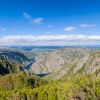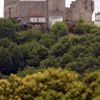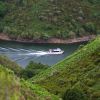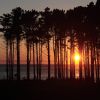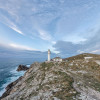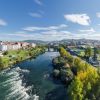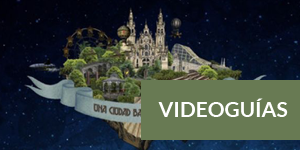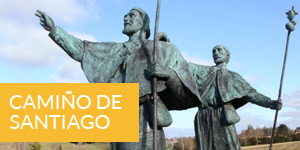- Accede I
- Regístrate I
- carrito
Ribeira Sacra – Cañones del Sil: Los Mares Interiores
Duración: 1 día completo
Itinerario: Monforte - Cañones del Sil - Castro Caldelas - Mirador Cabezoas - Sto. Estevo de Ribas de Sil.
Descripción: En sus últimos kilómetros antes de desembocar en el Miño, el río Sil fluye a lo largo de un profundo cañón, creando un paisaje fuera de lo común. Aquí se asentaron en los inicios del cristianismo monjes y ermitaños que, con el paso del tiempo, construyeron importantes monasterios que dieron lugar al nombre Ribeira Sacra. El río se puede recorrer en cruceros en catamarán que permiten disfrutar de lugares de otra manera inaccesibles. Contemplados desde el río, los viñedos, dispuestos en bancales, dan cuenta del esfuerzo del hombre por aprovechar al máximo estas tierras de las que sale la denominación de origen “Ribeira Sacra”, siendo en los tintos la variedad Mencía la más cultivada, y la variedad Godello para los blancos. La excursión incluye una parada en Monforte de Lemos.
Paradas recomendadas
Monforte de Lemos-Cañones del Sil-Doade-Castro Caldelas-Mirador Cabezoas-Santo Estevo de Ribas de Sil
La Ribeira Sacra comprende las tierras del interior en las que se unen los ríos más caudalosos de Galicia: el Sil y el Miño. En sus últimos kilómetros antes de desembocar en el Miño a la altura de Os Peares, el Sil fluye en la frontera entre las provincias de Lugo y Ourense a lo largo de un profundo cañón, que en algunos puntos alcanza una profundidad de unos 500 m, creando de esta forma un paisaje impresionante y poco común, seña de identidad de este territorio.
Estos parajes naturales tan potentes fueron ocupados en los inicios del cristianismo por monjes y eremitas de vida ascética que buscaban el silencio y la naturaleza privilegiada de estas tierras y que, con el paso del tiempo, levantaron florecientes monasterios. De ahí el nombre Ribeira Sacra, del que existe constancia escrita desde el siglo XII.
Además de cenobios, esta zona de Galicia cuenta con un valioso patrimonio, en el que no faltan castillos, iglesias, pazos y puentes.
El río es navegable en un tramo de 40 km, que se pueden recorrer en cruceros en catamarán que permiten disfrutar de los rincones más recogidos, inaccesibles de otra manera por lo difícil del terreno. En las alturas del Cañón abundan los miradores naturales colgados sobre al río, atalayas ideales para la contemplación de un paisaje de inusual belleza.
La vegetación de ribera se compone de bosques de robles, castaños y encinas. Entre los cultivos destacan los viñedos, dispuestos en bancales o 'socalcos', que contemplados desde el río dan cuenta del esfuerzo humano por aprovechar al máximo estas tierras de las que salen los vinos comercializados con la denominación de origen Ribeira Sacra, siendo en los tintos la variedad Mencía la más cultivada, con caldos de gran calidad afrutados y muy aromáticos y, aunque con menor producción, la variedad Godello para los blancos, que acompañan las exquisitas truchas de la zona.
Monasterio de Santo Estevo de Ribas de Sil
En la misma ribera del río Sil está el soberbio Monasterio de Santo Estevo de Ribas de Sil, cenobio benedictino originario del siglo VI, rehabilitado para uso hotelero por la marca Paradores. Conserva un notable claustro románico, aunque con alteraciones del siglo XVI. Además del románico, su estructura y decoración cuenta con elementos góticos, renacentistas y barrocos. En 1923 recibió el reconocimiento de Monumento Histórico-Artístico.
Mirador de Cabezoas
Una de las panorámicas más impresionantes de los Cañones del Sil.
Castro Caldelas
De Castro Caldelas impresiona su ubicación, con el imponente castillo en la cima de la colina, y los impresionantes bancales de las laderas. Son también de interés la Iglesia de Santa Isabel y el Santuario de la Virgen de los Remedios.
En catamarán por los mares interiores de Galicia
El recorrido en catamarán, un delicioso crucero por los cañones del Sil, transcurre por parajes de gran encanto. Las aguas remansadas y las formaciones rocosas del cañón crean un grandioso espectáculo para los sentidos. En las orillas hay pequeños embarcaderos utilizados por los vinicultores de la zona para transportar la uva en época de cosecha.
Desde el barco se ve, en lo alto, el famoso Monasterio de Santa Cristina de Ribas do Sil, iglesia del siglo XII con interesante rosetón románico y claustro del XVI, de cuyo ábside se cree que salía un túnel. Dice la tradición que si se pasa a través de los castaños huecos que hay en el entorno- 'caracochas'- se cura el 'tangaraño' -raquitismo-, pero seguro que también funciona con los males modernos.
Miles de historias y leyendas rodean este impresionante lugar, pero de entre todas ellas sorprende este relato de claras reminiscencias clásicas: el dios Júpiter se vio prendado de la hermosura de la tierra gallega, y para poseerla, la atravesó con un río, el Miño. Pero su esposa, la diosa Juno, no estaba por la labor de compartir su amor con una extraña, por lo que pensó que, si en la faz de aquella hermosa tierra abría una gran herida, Júpiter terminaría por repudiarla. Una herida que en algunos lugares casi alcanza los 300 m de desnivel en la vertical y que hoy son los maravillosos Cañones del Sil.
Doade
Aquí está la mayor extensión de cultivo de la vid de uva de Amandi, incluida en la Denominación de Origen 'Ribeira Sacra'. Se recomienda la visita a una bodega y la cata de estos excelentes caldos gallegos.
Monforte de Lemos
Considerada la puerta de la Ribeira Sacra, Monforte -'monte forte'-, villa medieval, cuenta con un extenso patrimonio: monasterios, castillos, palacios, conventos y puentes, que lo convierten en una parada imprescindible, en la que destacan el monasterio de San Vicente do Pino, la Torre del Homenaje y los exiguos restos del Palacio de los Condes de Lemos.
La herencia medieval monfortina se completa con las murallas y sus torres más las calles del casco viejo, como la Rúa da Cadea Vella, la rúa de Os Fornos o la rúa de O Burato, donde hay numerosas casas blasonadas. En estas rúas se asentó en lo últimos años de la Edad Media una numerosa comunidad judía -la más importante de Galicia junto con la de Ribadavia- que contribuyó a impulsar la vida comercial de la villa.
Destaca además el Puente Viejo -'Ponte Vella'-, construcción de origen romano -su actual configuración es del siglo XVI-, el Convento de las Franciscanas Descalzas -también llamado de las clarisas, que alberga uno de los museos de arte sacra más importantes de España- y el Colegio Nuestra Señora da Antiga, un imponente edificio renacentista conocido como 'el pequeño Escorial gallego', en cuyo museo se conservan varias obras de El Greco.
Como curiosidad, en Monforte está la casa más estrecha de España, de 1,50 m de ancho y 20 m de profundidad, que se compone de cuatro pisos y planta baja.











